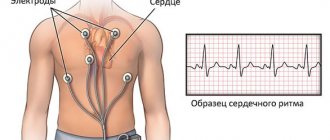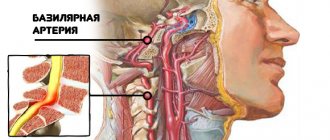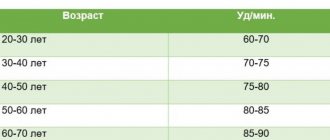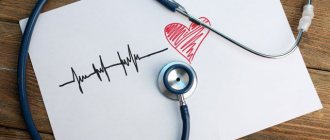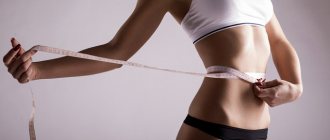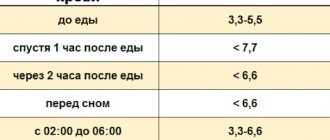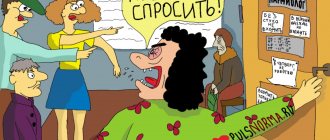A rapid heartbeat of 100 beats per minute attracts the attention of doctors, since it exceeds the norm, which for a healthy adult is 60-80 beats. It is considered absolutely normal for a person without heart pathologies if he does not feel his heartbeat. Increased heart rate during arrhythmia is called tachycardia; this condition requires normalization.
Causes of rapid heartbeat
If a person is at rest, then it is considered normal when he does not feel his own heartbeat. Tachycardia (increased heart rate above 100 beats per minute) can occur in healthy people under the following circumstances:
- strong emotional experiences;
- increased physical activity;
- changes in environmental parameters - lack of oxygen in the air;
- fever - with an increase in body temperature by 1 degree, the heartbeat increases by an average of 10 beats/minute.
In such situations, tachycardia does not indicate the presence of heart disease, but is a normal physiological reaction of the body.
The presence of physiological tachycardia is noted when hormonal levels change - in women during menopause. Sometimes the heart begins to beat faster due to an allergic reaction or after eating a large meal. Eating foods rich in caffeine is another cause of tachycardia.
The key feature of physiological tachycardia is the absence of accompanying symptoms:
- increased blood pressure;
- burning or pain in the heart area;
- dizziness and darkening of the eyes;
- fainting state;
- panic attack.
When the heart rate increases due to external factors, normalization of the heart rate occurs within a few minutes - for this it is enough to assume a state of rest.
During active physical activity, you should monitor your own pulse and be able to calculate the maximum heart rate. To do this, you need to subtract your own age from the number 220. So, for a 40-year-old person during sports training, the pulse should not exceed 180 beats per minute.
For a person leading a sedentary lifestyle, any physical effort (change of body position, sudden standing up) can cause an attack of tachycardia. In such cases, you can get rid of increased heart rate only through gradual and feasible training.
Danger and consequences
A pulse of 140 is not dangerous if it develops with adequate physical or emotional stress. When the room is too hot, a person is forced to move or is wearing tight synthetic or thick clothing, such indicators are also not a pathology. But if a symptom accompanies a disease of a particular organ, it poses a danger to human health and life.
Persistent tachycardia leads to arterial hypotension, decompensation of cardiac output, and decreased blood supply to organs. Through a pathological circle, this can lead to recurrent myocardial infarction or ischemic coronary syndrome.
Tachycardia as a symptom of the disease
Tachycardia at normal pressure can be caused by:
- obesity;
- diabetes;
- diseases of the stomach, thyroid gland.
The causes of tachycardia in women of physiological type are observed during menopause, with hormonal changes in the body and a decrease in estrogen levels. Estrogen stimulates the autonomic nervous system, affects the intestines, breathing, and heartbeat. For this reason, during menopause, when the concentration of estrogen decreases, the following symptoms of tachycardia occur in women:
- dizzy;
- shortness of breath appears;
- hot flashes occur;
- feeling of pulsation and fluttering in the chest.
The cause of the pathological disease is cardiac, vascular problems, disruptions in the functioning of other systems. The main extracardiac factors include:
- psoriasis;
- dehydration of the body;
- blood loss;
- temperature during a sore throat.
Often, when the disease is tachycardia, the causes may be pain syndromes of various origins and an increase in temperature. Frequent heartbeat can be observed in most heart and vascular diseases.
- Heart attack.
- Myocarditis, pericarditis.
- Heart defects.
In the case of idiopathic increased heart rate, it is impossible to determine the obvious factors of the disturbed rhythm. Therefore, if there is a rapid heartbeat, having eliminated the causes, treatment will be aimed at combating the disease.
Types of rhythm disturbances
A pulse of 105 per minute can be recorded with such rhythm disturbances as:
- sinus tachycardia;
- accelerated atrial rhythm;
- atrial fibrillation (while it is irregular);
- paroxysmal supraventricular tachycardia with concomitant atrioventricular block of the second degree with 2:1 conduction;
- coordinated form of atrial flutter with 3:1 conduction.
Of these, sinus tachycardia is most often recorded. It occurs when the normal source of heart rhythm (called the sinus node) beats faster than usual. You can independently distinguish sinus tachycardia from more serious rhythm disturbances by feeling the pulse and taking a deep breath. Usually, with such an arrhythmia, during inspiration, the heart rate changes - it slows down. Although such a sign with a pulse rate of 105 per minute can be difficult to determine on your own.
Accelerated atrial rhythms and supraventricular tachycardia are not associated with the functioning of the sinus node. Their source is a section of the conduction system of the heart, located in the atria, and activated for various reasons.
With atrial fibrillation and flutter, these chambers of the heart contract at a high frequency. If a significant part of these chaotic impulses is transmitted to the ventricles, a tachysystolic form of fibrillation, or atrial fibrillation, occurs, and irregular heartbeats are noted; pulse deficiency and irregularity are possible.
Atrial flutter is a rarer form of arrhythmia. It is accompanied by a blockade of some of the impulses emanating from the frequently contracting atria. As a result, every 2nd or, for example, every 3rd electrical signal from the atria is transmitted to the ventricles. A pulse of 105 with atrial flutter is observed with the 3:1 option.
How to diagnose tachycardia
With sinus tachycardia, when the increase in contractions of the heart muscle is associated only with external factors, a special examination, as a rule, is not required. But in cases where the increase in the number of heartbeats is not a consequence of stress or increased physical activity, it is necessary to undergo a number of manipulations to help diagnose tachycardia:
- electrocardiogram (ECG) - to determine the level and rhythm of contractions of the heart muscle at the time of the study;
- 24-hour Holter monitoring – helps to find out how the heart rate changes over a 24-hour period during physical activity, with low mobility and during sleep;
- Ultrasound examination of the heart, echocardiography – detects pathological abnormalities in the functioning of the heart.
Blood pressure must be measured; in addition, bicycle ergometry may be prescribed (hardware monitoring of the performance of the cardiac system during exercise on an exercise bike).
Rapid heartbeat can be caused not only by cardiac pathology, but also by other diseases of the internal organs. Therefore, in addition to specialized studies, it is advisable to take blood tests (biochemistry, electrolyte content, thyroid hormones) and urine.
Diagnosis of elevated heart rate
If a person registers a pulse of 105 at rest, what should be done? First, you should determine whether this condition is permanent, or whether it is temporary and associated with obvious reasons (stress, stress, pregnancy, and so on). If a rapid pulse is constantly recorded, you should consult a therapist.
What tests are recommended if your heart rate increases to 105 per minute or more:
- general blood test with determination of the level of hemoglobin, red blood cells, color index;
- general urinalysis to exclude blood loss through the kidneys;
- blood test for cholesterol and sugar;
- blood test for the level of thyroid-stimulating hormone (in hyperthyroidism it is reduced) and T4 (in hyperthyroidism its level is higher than normal);
- To exclude pregnancy, women are recommended to donate blood for hCG levels.
It is also recommended to undergo an ECG and fluorography of the lungs.
If, after examination by a doctor and laboratory tests, the cause of the increased heart rate is not determined, the patient is referred to a cardiologist.
Additional research methods aimed at diagnosing cardiac (“heart”) causes of increased heart rate from 105-106 to 107-109 beats:
- 24-hour ECG monitoring, which provides information about the true heart rate during the day, at night, at rest or during exercise. The study allows you to determine whether the daily average values differ from normal ones. It detects rhythm disturbances - atrial tachycardia, atrial fibrillation, atrial flutter and others. During monitoring, the patient carries with him a small recorder with a cable of wires throughout the day, which are connected with disposable electrodes to the surface of the chest.
- Study of ECG changes during exercise using a bicycle ergometer or treadmill test. It is necessary to determine a person’s endurance and fitness. Exercise tolerance decreases with poor physical fitness, heart disease, lung disease, diabetes and other diseases.
- Echocardiography is an ultrasound of the heart to identify its structural changes and diagnose heart failure, including at an early stage (this is evidenced by detected diastolic dysfunction, and later systolic myocardial dysfunction is added).
First aid for an attack
The first step is to create maximum rest conditions for the patient (half-sitting or lying down), unbutton his clothes to ensure a flow of fresh air. It should be noted that those around the patient should express calm and not cause panic. A person having an attack should take a deep breath and hold it, and then exhale slowly.
By performing such breathing exercises, the attack can be stopped. Emergency care for tachycardia can be as follows: changing the patient’s body position from horizontal to vertical and vice versa, straining for 50 seconds, inducing a gag reflex, Usher’s test (pressure on the eyeballs).
It should be noted that pressing on the eyeballs is not recommended if emergency care is provided for paroxysmal tachycardia in children, as this action may result in retinal detachment. If the first emergency aid for an attack of tachycardia does not work, drug methods should be used.
Take sedatives: 40-50 drops of valocardine, motherwort or valerian preparations and others (thus, emergency assistance can be provided for sinus tachycardia). When emergency care is provided for tachycardia, you must immediately call an ambulance.
Emergency care for ventricular tachycardia should be provided by qualified specialists, as it involves administering intravenous injections. Injections are given with antiarrhythmic drugs, cardiac glycosides, and sometimes electrical pulse therapy can be used.
Emergency care for supraventricular tachycardia with a medical approach is very quickly eliminated by using antiarrhythmic drugs (as a rule, the patient himself can know which drug will help him), but you can try to cope on your own without using serious medications.
How to reduce heart rate?
When the pulse quickens for no apparent reason, it causes fear and anxiety. The main thing in such a situation is not to be nervous and try to determine what is happening in the body. If tachycardia remains the only symptom, you should breathe deeply and remain calm. Warning signs may include pain in the heart area that radiates to the neck or arm, as well as numbness and trembling of the limbs. In most cases, they are absent, and you can calm your heartbeat at home quickly, thanks to several useful methods.
In many home medicine cabinets you can find drugs to reduce heart rate. They are available without a doctor's prescription and will help you quickly restore your performance. However, before taking them, it is important to find out the cause of this symptom, since different groups of drugs have different compositions and are indicated for tachycardia of different origins. So, the doctor may recommend the following medications:
- Valocordin, Corvalol
- drugs based on phenobarbital and plant extracts, available in the form of drops that need to be diluted in water; - valerian officinalis
- comes in the form of drops and tablets, it helps well with tachycardia caused by nervous tension; - rosehip or hawthorn fruits, motherwort root
- raw materials for the preparation of soothing decoctions, useful for calming the heartbeat; - if necessary
, medications to replenish potassium or magnesium deficiency (Asparkam, Panangin).
After taking medications, you should avoid physical activity. It is better to spend this day in a calm environment, avoiding stress and nervous tension.
Video - Rapid heartbeat. How to calm your heart
What does the heart need?
Of all the chemical elements, the heart needs most:
- iodine (products containing it have a beneficial effect on metabolism: these are sea fish, squid, shrimp, seaweed and other gifts of Neptune),
- potassium (it improves the activity of the heart muscle, promotes the removal of excess fluid: most of it is found in potatoes, pumpkin, cabbage, apricots, prunes, dried apricots, figs, rose hips, black and red currants, parsley),
- magnesium (this element has a calming, vasodilating and diuretic effect, maintains the tone of the walls of blood vessels, and therefore do not neglect porridges: oatmeal, millet, barley, buckwheat, as well as walnuts, peas, beets, carrots, salad; wheat bran is rich in magnesium, soy flour, sweet almonds, bananas.American scientists have concluded that those who receive at least half a gram of magnesium daily (that’s how much it is contained in one banana) have a minimal risk of heart attack).
And another gastronomic addiction of your heart is dairy and vegetarian soups: from cereals, vegetables. Do you remember the last time these dishes were on your table?
Traditional medicine to normalize heart rate
Along with medications, traditional medicine recipes can also prevent increased heart rate. Most often, medicinal plants are used in the treatment of tachycardia, which contain natural glycosides and herbs with a calming effect.
| Product name | Ingredients and preparation | Mode of application |
| Viburnum and cranberry balm | Viburnum and hawthorn (berries) - 1 kg each. Rose hips, cranberries - 0.5 kg each. Place in layers in a 5-liter container, sprinkle with sugar (you can use honey). Pour vodka to the level of the berries. Leave in a dark place for 21 days | 30 g twice a day - morning and evening. You can use berries from balsam to make compotes |
| Oriental Heart Balm | Lemon (with peel) – 500 grams. Dried apricots, raisins – 500 grams each. Walnuts (kernels) – 500 grams. Grind using a blender, add 1 kg of honey. Store in a cool place | 1 teaspoon per day in the morning |
| Clover tincture | Place fresh clover flowers in a container (liter jar) and fill with vodka. Infusion time: 30 days in a dark place | 1 teaspoon three times a day, after meals |
Take a medium sized head of garlic and make a paste from it. We put everything in a jar, fill it with unrefined sunflower oil and leave it at home inside the refrigerator for the whole next night. In the morning, cut out the top of a ripe lemon with a knife and squeeze fresh juice into a teaspoon. Let's add a little garlic oil.
We make butter this way. Peel 2 garlic heads and cut them into small pieces. Place in a jar made of any glass and fill with vegetable oil (about half a glass). We store the jar in the sun for 11 days, stirring it every day. After 11 days, filter and add 1 drop of purified glycerin (sold at the pharmacy). Let's put everything into a bottle, but now from darkish-colored glass with a good cork. It belongs in the refrigerator. Treatment at least three times in one day. The course is usually allowed for up to 90 days.
Prevention of tachycardia
The best method for preventing tachycardia is to reduce the risk of developing one of the many heart diseases. It is often because of them that irregularities in the heart rhythm appear. To avoid illness, you should constantly monitor your indicators - this will help you notice any deviations in a timely manner and eliminate the problem at an early stage. To reduce the risk of tachycardia, it is recommended to take simple measures of the following nature:
- Regularly engage in physical training to the best of your ability;
- Lead a healthy lifestyle, including a healthy diet with enough fruits, whole grains and vegetables;
- Limit consumption of fatty foods and quit alcohol, drugs and smoking;
- Maintain body weight in the optimal range for your gender, age, weight and professional activity;
- Control blood cholesterol levels;
- Reduce your consumption of coffee and caffeinated drinks to a minimum.
It is also important to use any medications with great caution. From a young age you need to monitor the normalization of blood pressure, and especially in old age. It is necessary to try to avoid psychological stress. Regular visits to the doctor will help you take preventive measures in a timely manner and prevent the development of tachycardia.
You should be aware that caffeine can have an extremely negative effect on your heart rhythm and lead to arrhythmic conditions. It is impossible to say unequivocally what excessive caffeine consumption is, since it is very individual for each person. For some, a cup of coffee a day will not do any harm, but for others, even one cup a week may do a disservice.
Therapeutic measures
The disease is always better and easier to prevent. But if it does affect the body, it is necessary to provide adequate first aid to a patient with tachycardia. A number of potent medications are used for this. In the future, such patients are prescribed a special drug regimen for lifelong use.
Preventive measures
In order to prevent a pathological increase in heart rate, the patient must adhere to the following rules:
- Lead a healthy lifestyle. Quitting smoking and alcohol and substance abuse will help reduce the risk of tachycardia.
Avoid excessive stress. To do this, you need to study mental hygiene and try to adhere to all its rules.- Attend diagnostic examinations regularly. This is especially true for patients at risk who are prone to atherosclerotic vascular damage and have a high concentration of low-density lipoproteins in the blood.
- Engage in moderate physical labor. Exercise within reasonable limits is beneficial for the body, as it stimulates cells and tissues to renew themselves.
First aid
Faced with an increase in heart rate, a person asks the question: what to do in such a situation, how to help yourself or a loved one? First of all, the patient needs to calm down. To do this, he must take a sitting or lying position and, if possible, seek help from others or call an ambulance. If tachycardia is accompanied by chest pain, you should take a Nitroglycerin tablet.
To stop an attack of tachycardia, the treatment regimen includes the following drugs:
- antiarrhythmics Amiodarone, Cordarone;
- some calcium channel blockers: Verapamil, Amlodipine, Nifedipine;
- beta blockers: Propranolol, Bisoprolol, Atenolol and Carvedilol.
